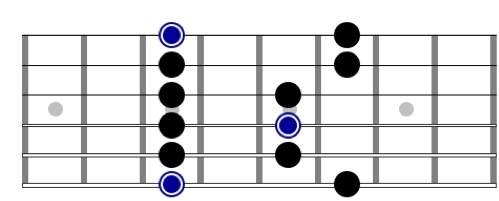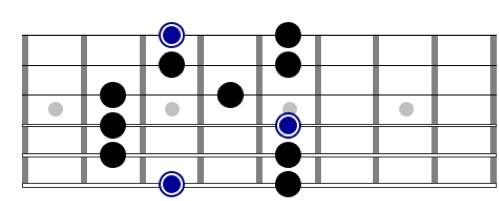Have you ever wondered how to work out the key of songs with your guitar? Today I want to share my method and show you how easy it is to find the key of songs by ear.
I was inspired to write this because I was on Youtube recently and I happened to stumble upon the worst lesson on this that I could imagine. I’m not picking on some random video with a few views here — this was a video specifically called “Find the key of any song”, and it was on a guitar channel with almost half a million subscribers.
I won’t mention the video – to protect the guilty – and, more importantly, because I don’t want you to look it up and waste even five seconds watching such a bad lesson. However, I can describe what it was like, because there are many lessons like this on Youtube.
In the space of not even five minutes the video raced through years worth of Music Theory, and then ended abruptly leaving you with no clear “what to do” to actually find the key of a song (- the whole reason you’re there). If you were someone who understood the level of music theory in the lesson, then you would already have this skill down and wouldn’t need to be watching the video in the first place!
I can’t help but get the impression from videos like this that you’re really just there to clock up the view count, sit through an advert, and then be sold a product to solve the confusion the video has created.

I call these kind of lessons “circular lessons”. These are “lessons” where you would need to already understand the lesson in order to understand the lesson. One of the comments I saw underneath perfectly summed up how I think most people must feel after watching videos like these:
And I was reminded that a lot of musicians have a truly incredible gift...
…for making things way harder than they actually are. You’d need to be a music teacher yourself to understand what was going on.
The truth is that you do not need to know a truckload of Music Theory to work out the key of a song. In fact, all you really need are your ears and a couple of simple scales that you probably already know.
I’m going to show you how in a minute, but first:
What does the word “Key” actually mean?
It’s a term that is used all the time, but let’s make the word “key” more concrete. The key of a song really means:
Key = The SCALE that the notes in the song come from
The key simply means the scale the piece is in. Every piece of music draws its notes from one or more scales. This is why the names of keys are things like “A Major” — they’re the same scale names. Because it’s saying: “This piece is in the A Major scale”. If we say a song is in “C# Minor”, it’s because the melody uses the C# Minor scale, and the chords derive from the C# Minor scale.
The key is something you need to be able to work out for yourself because it will not always be written down, and knowing the key is the only way players can jam with a song or a piece of music using the right scales and modes. Without knowing the key, you can’t use anything you know in the right musical context.
A key’s name consists of two parts:
a Note Name + a Quality
The first part of the key’s name is the name of the note that starts the scale we’re in, and the Quality is either Major or Minor. The Major or Minor part describes whether the key has an overall atmosphere we would describe as basically “happy” or basically “sad”.
A key can start from any note, and it can be either Major or Minor type.
This means that finding the key really means determining two things:
1) What note the scale starts on, and
2) Whether the scale is Major or Minor-type
And this means the first thing we need to do is work out what note the scale starts on. This very special note is called the Root Note.
The Root Note
The proper name for the starting note of a scale is the Root Note. The Root Note is a fundamental principle of how music works, and it is the most important concept you need to understand to work out the key of a piece of music.
The Root Note is the starting note of the scale and the one central note in a piece of music which all the other notes gravitate around and fall back to. The Root is the one note that sounds like “home” in a piece of music. Picture the way the planets orbit around the Sun, and how everything depends on the Sun in the centre to provide their gravity. The Root Note is a bit like this:

Another way to picture the Root Note is to think of the roots of a tree. All the leaves and branches in a tree are supported by the its roots, in the same way that musical notes need a “base” to make music from.
Every piece of music ever written has — must have — a Root Note. Without a Root Note to establish a home base, musical notes and sequences would just sound like meaningless pitches; noises, not music.
Step 1: Identify the Root Note
The Root Note is something you hear, but also something you feel and sense. If you put on any piece of music and listen to it, we’d find that at any given time there was one note that all the melodies and chords were gravitating around and falling back to. This sense of falling back to or returning home is called “resolving” in music, and this is the feeling we’re listening for to identify the Root Note.
Listen to some songs, and listen for a note that stands out as being the note everything resolves to — it will often be repeating a lot more than others, or appearing frequently at the start or end of song sections. Hum, whistle or sing the note you think the music falls back to.
The Root Note has a cool property which marks it out when you find it — you can play it over entire sections of the song and it sounds like it fits well with everything. If it sounds odd for a few seconds over a particular chord, you will hear it – if you’ve got the right note – “resolve” itself a moment later.
If you’re really not sure then you can literally just start running your finger up and down the low E string, picking higher or lower notes and humming with them over the tune until you hit something that sounds like it could be it. Once you find the note you think it could be, it’s time for step two:
Step 2: Get out the Pentatonic Scales
These are extremely common scales in Blues, Rock and Metal, but if you don’t know them already (or if you’ve only seen one of them before – most likely the Minor Pentatonic), here are what they both look like:
The Minor Pentatonic Scale

The Major Pentatonic Scale

We’ve got our Pentatonic scales at the ready, and now the final step is:
Step 3: Test out the Root Note
Starting from the note you think is the root, play the Minor Pentatonic scale. If you’ve got it right then the scale will sound cool. Playing through its notes will sound like you could start improvising a bluesy rock solo to the song.
If the Minor Pentatonic scale fits with the song then congratulations; you’ve found the key.
Most rock songs are in a Minor key, so it makes sense to test your Root Notes with the Minor Pentatonic first. If the Minor Pentatonic scale sounds off and doesn’t fit with the first note you try, then just pick another note you think it could be and try it with the Minor Pentatonic scale again.
If it still doesn’t work then you either have the wrong Root Note or the wrong scale. If you think you have the right Root Note but the scale sounds wrong, then that’s when to try out the Major Pentatonic scale.
Keys can only be Major or Minor, so if you have the right Root Note then one of the Pentatonic scales is going to work. If neither scale works then it cannot be the right Root Note, so just find another note to try and repeat the process.
Finding the key by ear is always an imperfect art, but with a bit of practice you will be able to identify the key of any song within a few seconds on your guitar.
With practice you’ll become very fast at just hearing whether a song is in a Major or Minor key, and then you can just focus on quickly narrowing down the right Root Note.
A lot of people think this is some kind of special ability when you can do it so effortlessly, but it’s a listening skill that you can learn.
And that’s all there is to it
Let’s recap the process in plain English:
Step 1: Fish around for the note that could be the Root Note
Step 2: Test it out with the Pentatonic Scales
Step 3: Repeat steps 1 and 2 until you find the correct key
There are only 12 notes in music, and the key can only be Major or Minor, so you just test and re-test notes with the two scales until you find what fits.
And that’s it. That’s how you do it, and it works for all styles of music. No advanced Music Theory required. In fact, it’s more like the other way around — this skill is required before you can begin to make sense of Music Theory.
What if there’s more than one key, or the key changes during a song?
It doesn’t matter. If and when you sense the key of the song has changed (and you’ll know because the scale will stop fitting), then just repeat the process to find the new root note and key the song has moved to. Easy.
The world is now your jam track!
With this skill you don’t even need to be told the key of things anymore. With some practice you’ll be able to put on any piece of music in any style and just pick up your guitar and start playing with it. Try it out and see how you get on!
PS If you want to check the key of a song you’re not sure of, ask me in the comments below or even send me an email. It only takes a second or two to find so I’d be happy to help out if you’re unsure.
– Christy